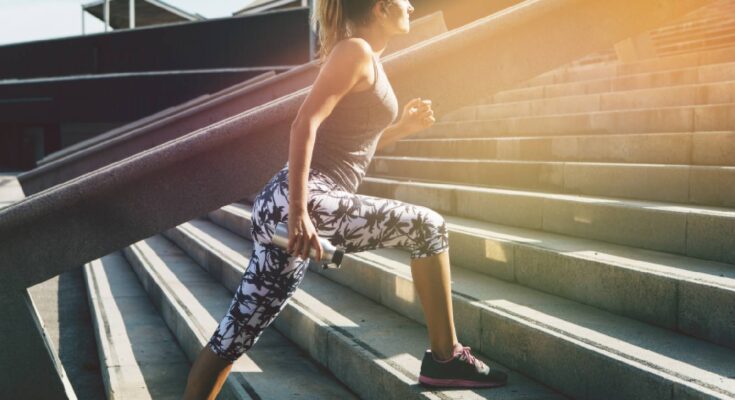Step-up exercise delivers a variety of health benefits. From toning all your leg muscles to enhancing stability, here’s why these must be added to your workout regimen.
If you want to work on your butt and legs, then find a box, and learn the right way to do step-up exercises. Step-ups are a lower body compound exercise that is done by stepping onto an elevated surface like a box or a step. These exercises work the glutes, adductors, hamstrings, quadriceps, core, and calves. These can also help to enhance stability and reduce muscle imbalances between the two legs by working on the legs unilaterally. You can progress in step-ups in two ways: by adding weight, or by increasing the height of the step. The higher the step, the better for your glutes and hamstrings.
What are the benefits of step-up exercises?
Step-ups are awesome body resistance routines that work muscles in the legs and buttocks. They are great for strengthening the muscles in your lower body and enhancing core strength, stability, and balance, says fitness expert and nutritionist Sonia Bakshi. Some of its key benefits include:
1. Stability and balance
Step-up exercise improves stability and balance when practised regularly. As per a study published in the Journal of Physical Therapy Science, step-up exercise helps to improve balance because you need to control the weight as you move up and down, forward and back. With years of practice, this exercise helps you avoid falls, especially when we grow old. Another benefit is that this exercise strengthens the legs individually, building equal strength.

2. Builds strength
Step-ups increase the strength of the legs and helps build muscle too. They work the glutes, hamstrings, quadriceps, calves and core. So, this exercise helps strengthen the lower body muscles. With more strength in the lower body muscles, you will be able to perform the other exercises better. Check out how step up exercises on stairs can help you reach your fitness goals.
3. Aids weight loss
Step-up exercise increases the heart rate which helps burn more calories. You can add step-ups while weight training or during resistance training to burn more calories. They make an excellent cardio exercise which in turn can aid in losing weight. Also, cardio exercises can help improve cardiovascular health.
Also read: 5 must-try aerobic step exercises to enjoy a fun weight-loss workout
4. Strengthens knees
Since step-up exercise works on every muscle of the leg, you will have stronger knees in no time. By doing weighed step-ups, you can build strength in the quadriceps (front of the thigh). As per a study published in the Journal of Experimental Orthopaedics, this exercise also helps build your quads, you can protect your knee and step-ups, if done correctly.
5. Versatile and easy to do
Adjust the height of steps as per your fitness levels and enjoy increased fitness and variety in workouts. Also, step-ups are an extremely easy exercise and can be done almost anywhere since you need the bare minimum equipment like a step, box, or bench, and some weights. These exercises are also a great alternative to other lower body exercises such as polymetric jumping because it is seamless to do and lower impact.
Are there any variations of step-up exercise?
Step-up exercises are fun if you perform them by adding variations. Here are some variations of the step-up exercise:
1. Lateral step-up
Similar to a squat, this variation involves placing one foot on a box and the other on the floor. Push through the raised foot to stand on the box.
2. Alternating step-ups
Step up onto a box with one foot, then step back down and repeat with the other foot.
3. Peterson step-up
Stand on the edge of a box, lift your heel off the ground, and step down while barely touching the opposite heel to the ground.
4. Lateral step ups
Step up with one foot sideways onto a step and balance on that leg as you hover the other foot off the floor.

Are there any side effects of step-up exercise?
Any exercise when overdone can hurt, and step-up exercises are no exception. Step-up exercises can cause injury if done incorrectly or if you overdo it:
- Back pain: If you don’t perform step-ups correctly, they can cause back pain. Weighted step-ups can be especially difficult for people with lower back pain.
- Overworked muscles: Overworking a muscle group can lead to injury. To help your body recover, you should include rest and active recovery in your exercise routine.
- Knee problems: If your knees turn in, out, or go past your toes, you should focus on stabilizing your leg before adding weight.
Common mistakes while doing step-ups
You can get the most out of your step-up exercise by avoiding these common mistakes and lowering your risk of injury.
1. Knee passing toes
You can guard the knee of your active leg by not pushing it past your toes while stepping up. Pushing the knee far forward changes the muscles used and puts more stress on the knee joint.
2. Rounding your back
When you’re doing step-ups, keep your back straight and your abdominal muscles nice and tight. Make sure your foot is placed entirely on the step. It is okay to start with a low step height as well. For this exercise, be more focused on your form than the step height. When you step up, alternate your lead foot each time. Do as many repetitions as you can, depending on your fitness level, and stop when you feel tired or your form begins to suffer.
3. Pushing up with lower leg
All the work while doing step-ups should come from the leading leg. It simply means bringing the trailing leg up as dead weight. When you push up using your lower leg, you are reducing the load on the leading leg.
Keep these in mind while doing step-ups:
1. Lean forward gently to activate your glutes and hamstrings.
2. Avoid rounding your spine and putting too much weight on your lower back.
3. Keep 2 days gap between leg days
Also read: Dumbbell exercises for weight loss: 9 best strength training moves
Frequently Asked Questions (FAQs)
1. Do step-ups build muscle?
Step-ups are strengthening exercises and can also aid in building muscle in the glutes, quads, and hamstrings if performed on a regular basis, with progressive overload, over time.
2. Can you lose weight by doing step-ups?
Even though step-ups can burn calories, they are less likely to help with weight loss unless they are combined with a calorie deficit. Performing strength exercises like step-ups can guard against muscle loss while in a calorie deficit. They can also help you build muscle which means you will be burning more calories at rest.
3. Do step-ups tone your bum?
Step-ups aid in building and strengthening the gluteal muscle, which can create a fuller, more toned bum.
Source link






